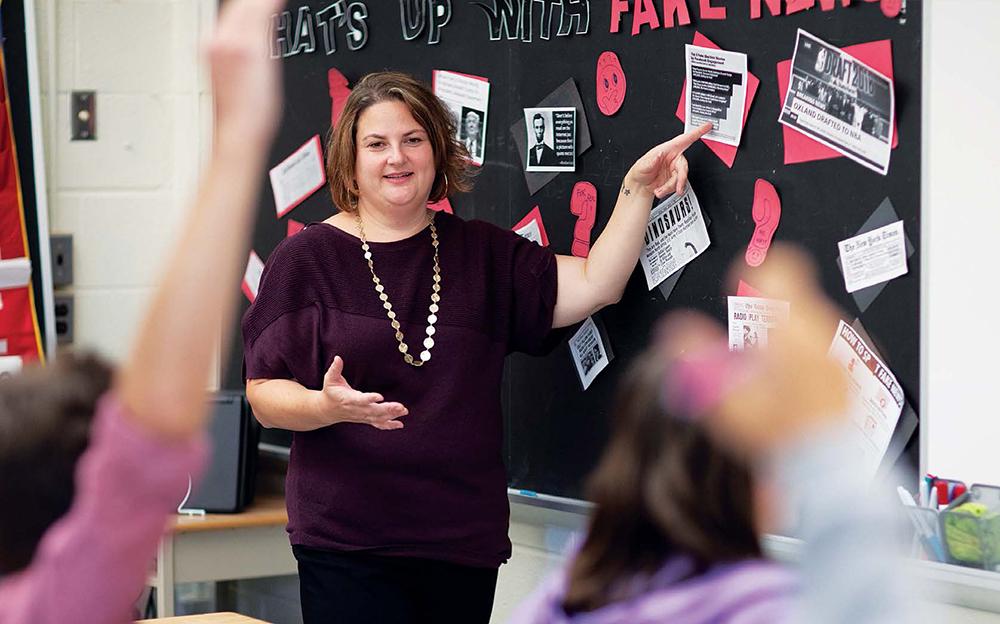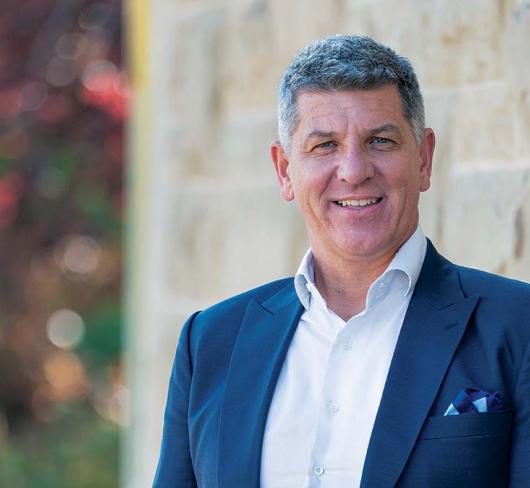
Fighting 'Fake News' in the Classroom
There are many words to describe the misinformation that circulates online: clickbait, hoax, ‘fake news,’ disinformation, misinformation, memes, native advertising. And the list keeps getting longer. What this terminology points to is the fact that our students are facing the most complex and challenging information environment in history. For all its benefits, the communication revolution of the internet has created enormous challenges when it comes to assessing the volumes of information that come through online platforms.
As an intermediate teacher at Dr. M. S. Hawkins Senior Public School in Port Hope, Ontario, I consistently talk about news and information literacy with my students. I have been teaching a unit on misinformation for the past five years. The need arose as I found more of my students wanting to discuss the outlandish claims they were reading online, especially in the arena of American – but also Canadian – politics.
I like to begin my misinformation unit by collecting a bulletin board full of headlines. I’ll post sensational ones from the internet, screenshots of inaccurate tweets linking to news articles, Facebook posts, tabloid headlines and a screenshot of CNN I manipulated to show an unlikely NBA draft pick – me. As a class, we work through lessons on identifying fake news, ways to stop its spread and the reasons such media is created. When I challenge my students to think through these topics, there are more questions than answers.
Last spring, I began using a new set of news literacy resources in my classroom, which have added a welcome new dimension to my teaching on these themes. NewsWise (newswise.ca) is a news and information literacy initiative from CIVIX, the organization behind Student Vote. It launched as a pilot in May, alongside the Ontario provincial election, with free interactive resources that address themes around news and journalism, along with concerns related to internet algorithms, social media and the spread of misinformation online.
The Rise of 'Fake News'
It’s hard to discuss ‘fake news’ without talking about the 2016 US presidential election. This event marked a turning point in public understanding of what leading experts now call ‘information disorder’ – the mass spread of misinformation online.
In the summer of 2016, when ‘fake news’ was not yet a household phrase, Pope Francis shocked the world by proclaiming his support for Donald Trump in the American presidential race. The story went viral on social media, picking up more than a million Facebook likes and shares in a matter of weeks. It was entirely fictitious, of course, published by an official-sounding site called WTOE 5 News.
Those curious enough to click through to the source might have found key context on the site’s “About” page. It acknowledged its own lack of credibility stating, “most articles on wtoe5news.com are satire or pure fantasy.” Other outlets picked up the story, trying to capitalize on its popularity. In this way the source became harder to trace and evaluate, a huge problem with the spread of false information online.
In the two years since that election, ‘fake news’ has hardly left the real news, as people have added words like ‘troll factory’ and ‘bot’ to our vocabularies. We now know there is a dizzying array of misinformation online, and we are grappling with what it is, how it spreads and how to stop it.
Understanding 'Information Disorder'
The phrase ‘fake news’ may be a convenient label, but it describes too many things to be very useful. This is particularly true now that politicians and others use the phrase to dismiss credible reporting they don’t personally agree with. I also see this in my classroom. Not only will students argue that certain fake news articles are accurate, some are vocal that legitimate news stories are, in fact, fake.
The lack of precision of the term ‘fake news’ has caused many who study the problem to abandon it altogether. Claire Wardle, head of the Harvard-affiliated First Draft (firstdraftnews.org), is a leading expert in this area. Wardle prefers the term ‘information disorder’ to describe the problem, and breaks it down into three parts: disinformation, misinformation and mal-information. Disinformation refers to fabricated content that is intended to cause harm (including foreign-sponsored campaigns designed to undermine democracy). Misinformation refers to wrong information that is not intended to cause harm, and can include clickbait stories with a profit motive, photoshopped images, satire that’s lost its context and more. Mal-information is true information used against someone, such as by hacking emails and using the content for political or other advantage.
In analyzing misinformation, it is incredibly important to categorize it. A tweet about a celebrity death hoax may belong to the same overall problem as a meme promoting Islamophobia, but motives and impact are much different. Asking students to categorize or discuss types of misinformation is helpful for understanding the range and nuance of different types of faulty information.
To understand the problem of information disorder, students also need background in traditional news media. What sources of information can be considered reliable, and what qualities make those sources more trustworthy? Understanding how the media works and why journalists, who follow ethical guidelines, have historically been trusted to deliver news, is important. While it’s necessary for students to know that not all information is equal, it’s also important to apply critical thinking to trusted news organizations.
Integrating the News
One of my first steps with my students is to integrate the idea of news into my students’ daily lives. We watch CNN10 and CBC, explore newspapers in paper and digitally, examine newsmagazines and look at social media feeds from news organizations. It doesn't take long before students start actively asking for the chance to watch or read the news. Next, I get students to jump online and complete NewsWise’s verification lessons. The videos are engaging and take students through the steps to use in online searches to see if information is legitimate. Students love being hands-on with fake images and happily pull out their devices to see if the celebrity accounts they are following are verified or not. Once students master these basic skills, they are ready to tackle larger stories.
NewsWise is a flexible resource that lets you tailor lessons to your class and present material in the order that works for you. My class needed the online, practical application of skills to get excited and curious about journalism in general. I then introduced the standards of journalism, linking them to standards we have in class about behaviour, and posted the questions on the wall. Groups discussions were full of ideas and impassioned debate.
Journalistic Standards Questions
- Sourcing: Does it include multiple reliable sources?
- Accuracy: Have the facts been sourced and verified?
- Research: Are there secondary sources? Have statistics been cited and if so, from where?
- Context: Does the story go beyond the news event to include history or background?
- Fairness: Is neutral language used to describe the people and issues?
I added a final project that allows students the chance to write and edit a classroom newspaper. Students spend a month writing and then need to decide if the articles by their peers meet journalistic standards. Using NewsWise videos and activities in which Canadian journalists and editors explain what kinds of stories are pursued, students are guided in determining what leads, how to create appropriate headlines and how to captivate readers. This process gives students a different perspective on the influence newsmakers have in what and how stories are created and presented.
The Need for Better Tools
In the past few years, my brief first-day survey of students has revealed that close to 100 percent of my grade 7 and 8 students come to school with a smartphone. The amount of information at their fingertips leaves educators with a huge task of helping students navigate the world of media.
Over the years I have found my students’ attitudes toward fake news become alarmingly complacent. While they have accepted it as a part of life, student understanding of how, why and by whom this misinformation is created, is limited at best. Their existing critical skills are rarely a match for the misinformation they encounter. Current research lines up with these observations. There’s a perception that digital natives are savvy about everything online, but the ability to use technology is different than understanding what it shows you.
Providing my digital-savvy students with explicit teaching about misinformation has shown me just how much they have to learn. Every year I do this, the technology changes, those spreading misinformation become more adept and the number of tools to combat it continue to grow. I’m always learning new tricks to teach my students and they often find great solutions to teach me. Incorporating critical thinking skills in digital media can no longer be encapsulated in a single unit of study, but needs to be spread throughout the year. At the heart of this discussion is the safety and comfort of our students when they venture online. It’s important they have as many tools up their sleeves as possible to help them navigate their world.
NewsWise resources are available to download at newswise.ca/educate.
Erin Oxland is a member of Kawartha Pine Ridge Teacher Local.
Tips for Information Literacy
Evaluating information online can be challenging. These tools and strategies can help.
Check your emotions
Those who fabricate news know that when people feel an emotion, they are more likely to share information. If a post makes you angry or excited, that’s when you want to stop and check the facts.
Use Google News
If you’re not sure if a rumour or report is true, searching Google News can help because it draws results from news sources, instead of the whole web. If that favourite celebrity has truly died, you’ll see reporting on it here. If you don’t see reporting, chances are it’s a hoax.
Reverse image search
Much of the misinformation online is visual, and tools such as Google image search can be an engaging hook to investigate memes.
Look for the checkmark
Social media is full of copy cat and fake accounts. Look for the verified checkmark to identify the real ones. Keep in mind that a checkmark doesn't mean the source is reliable, only that it belongs to the person identified.
Know there is trustworthy information
It may be tempting to think all information is suspicious, but when information is fact-based and verified, it is worth trusting. This may come from a professional news organization, a fact-checking group or an independent website that practices journalism using professional standards.
Identify the source
Online, it’s not always obvious who is putting out what information. Looking at a fact, story or claim, the first step is to figure out who produced it, so you can evaluate that source. Can you see who wrote or published the information? Look up the person or organization to evaluate it.
Check Wikipedia
Wikipedia has a bad reputation as a source, but it’s an excellent place to start research. An organization’s entry will often offer useful context. Look for ‘credibility signals,’ including how old the publication or organization is, what its budget is and how large its audience is. These aren’t always perfect measures, but offer useful reliability clues.
Keep a list
Once you’ve researched a source and determined it is credible, write it down in a list, so you won’t have to look it up next time. This way, over time you will build knowledge of what sources are known to be trustworthy.
Leave the page
Often we try to analyze a source or article by looking closely at it, reading its ‘About’ page, looking for clues about its context. On the web, you can get a faster, fuller picture by leaving the page to do some research to see what others say. Rely on credible sources, of course.
Look for existing fact-checks
There are many people doing the hard work of investigating claims and publishing the results online. Sites such as Snopes.com, FactsCan.ca and FactCheck.org investigate and debunk claims, and show the work behind their conclusions.

